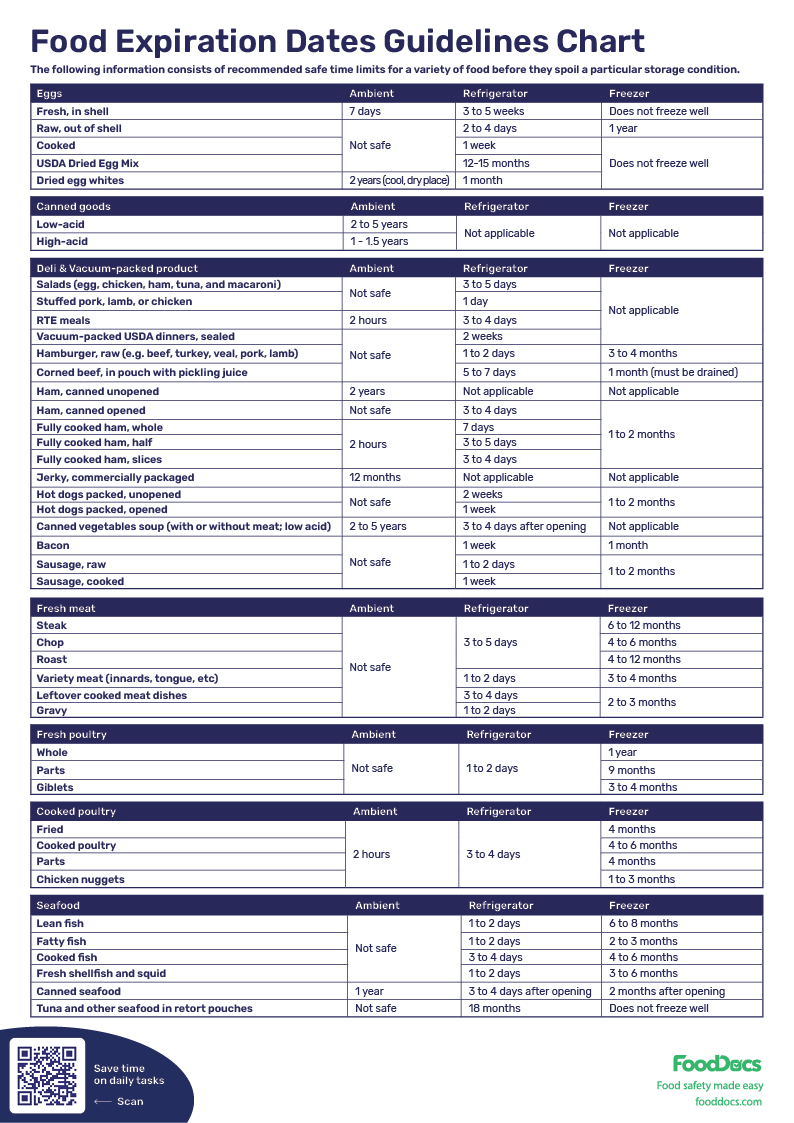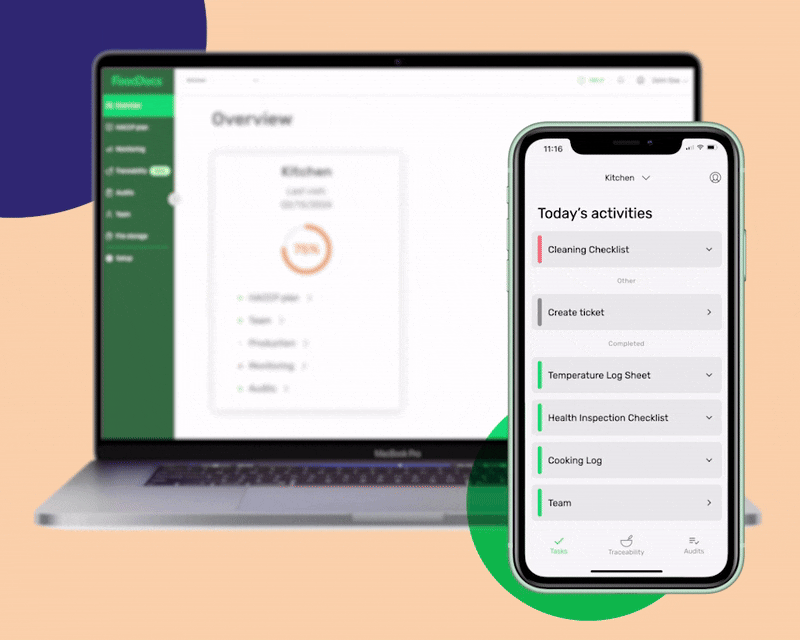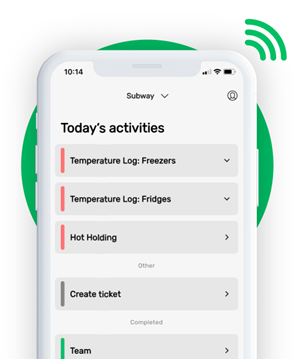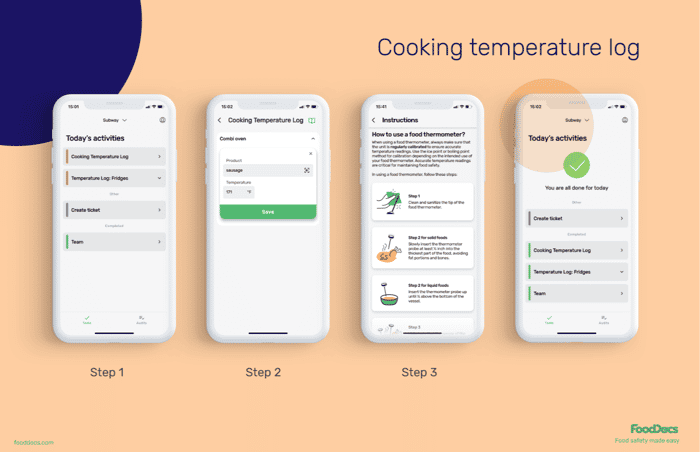FOOD EXPIRATION DATES GUIDLINES CHART


This is how our Digital Food Safety platform saves 20% of your time on daily tasks:
- Get upcoming task notifications
- Add data into the app
- Check the status of tasks in real-time

When food safety was still handled on paper, I typically spent a couple of hours per day getting the papers and going around checking or completing tasks… Now I can sit down and it's just all there in one place. It takes me 5-10 minutes.
Ruth B.
Store Manager
Ever wondered how long your food really lasts? Discover the facts behind expiration dates and how mastering them can drastically cut down on waste and safeguard your health.
And download your copy of the printable food expiration dates guidelines chart!
Key takeaways
- While many foods have a long shelf-life, they all eventually reach a point where they may lose quality and safety, necessitating the use of expiration dates.
- There is no federal law requiring expiration dates on food products, except for infant formula, yet food businesses often use these dates to ensure safety and quality.
- Expiration dates are crucial for preventing the use of spoiled or unsafe foods, especially highly perishable items.
- The Food Expiration Dates Guidelines Chart is a tool to help food handlers manage the shelf-life of various food products effectively.
- Food expiration dates can differ greatly depending on food composition, storage conditions, and packaging.
- Proper storage conditions, including temperature and cleanliness of the storage area, are vital for maintaining the reliability of expiration dates.
- Monitoring key parameters such as storage temperature and packaging type is essential for ensuring food safety and quality.
- Adopting digital tools can significantly reduce the time spent supervising food safety practices and help maintain accurate expiration monitoring.
- FoodDocs offers digital solutions to help manage food safety tasks, including monitoring expiration dates and maintaining proper storage conditions.
WHAT WE'LL COVER:
Food expiration dates guidelines chart: why does it matter?
While there are foods with a very long shelf-life, there is no absolute when it comes to the stability of a variety of foods. Even the shelf-life of common pantry foods such as canned goods, beverage items, and condiments have an expiration period or lose their acceptable quality and safety. Businesses in the food industry use expiration dates to indicate the maximum time for quality and safety.
Food businesses that deal with highly perishable food products can prevent food waste or the use of unsafe products if properly guided. To help food handlers remember such a piece of important information, you can use our Food Expiration Dates Guidelines Chart.
Currently, there is no absolute Federal law that requires food businesses to indicate the expiration dates of foods except infant formula.
Despite this, food businesses are encouraged to know expiration date guidelines to help them use fresh ingredients to prepare dishes. For some, expiration dates may be a quality concern, but safety is also an issue for some products.
What are expiration dates?
Expiration dates refer to predetermined dates indicating the allowable consumption of foods. This information acts as a guide for food businesses and consumers regarding the maximum food shelf-life estimates. In some food products, the expiration date appears as a series of letters and numbers.
Unlike the "use-by" date, expiration dates or sell-by dates may indicate that the food is no longer safe to consume after exceeding it. Additionally, expiration dates may indicate the maximum period in which foods still have the nutritional value they claim. The vitamin content of perishable products that have exceeded their recommended storage times may be less.
Foods that may have gone past their expiration date may potentially be no longer safe to consume, such as products like baby formula. Although expiration dates are not strictly indicative of maximum food safety, food handlers can still use them as precautionary guides. It may be because the added food additive is no longer in effect after the expiration date or the estimated integrity of the packaging has faltered. This scenario can encourage the growth of foodborne microorganisms such as spoilage bacteria.
Aside from deterioration of food quality problems, foods that have gone past their expiration dates may not be as safe as they used to be. As such, caution must be exercised. If the grace period and correct food storage conditions are not indicated on the packaging, then food businesses must practice caution in using the ingredients to keep foods safe.

What is shelf-life?
The term shelf-life refers to the period of time in which a product remains stable and safe for consumption. Stability, in terms of shelf-life, means that there is no expected change to occur on the product and that the food item is at its optimum quality. This applies both to product quality and safety. The end of a product's estimated shelf-life is denoted by the expiry date.
Food products, shelf-stable foods, raw, and ready-to-eat foods, have recommended shelf-life. This information is very essential for food handlers. Past a food item's shelf-life, changes that may potentially be dangerous can occur to the food.
On the other hand, it can also mean that the quality of the product is not the same as its original. Significant changes may occur past the recommended shelf-life of foods.
Food storage shelf-life is significantly affected by environmental conditions. A recommended storage shelf-life normally has a suggested storage temperature.
For example, the estimated shelf life of raw foods such as ground beef is 3 to 4 months under freezing conditions. This estimation is only applicable specifically if the ingredient is stored in the freezer. Higher temperatures will shorten the shelf-life of the food.
In addition to storage conditions, shelf-life is also affected by the packaging material and the method of packaging employed. Canned foods, freeze-dried foods, and vacuum-packed products typically have a longer shelf-life than the unprocessed type of food. Additionally, dried common foods are more stable than high-moisture ones.
What is the Food Expiration Dates Guidelines Chart?
The Food Expiration Dates Guidelines Chart is a visual tool that can guide food handlers regarding the maximum shelf-life of food products. Depending on the composition and nature of a food product, it may have a different expiration date.
Highly perishable foods such as those in the category time/temperature for safety or TCS require refrigeration and will spoil fast under ambient temperature. Products such as fatty fish and cooked meats have a shorter shelf-life than pasta and canned meat.
On the other hand, more shelf-stable products such as canned goods or free-dried products can last more than perishable foods even at ambient temperatures. As such, our Food Expiration Dates Guidelines Chart can become a useful reference for monitoring and labeling your food products. This chart can also help food handlers track the shelf-life of foods and prevent any food waste.
Who needs a Food Expiration Dates Guidelines Chart?
Although not generally required by law, food producers can indicate the recommended expiration date of the food they sell. This acts as a guide for food service businesses such as restaurants as well as consumers who receive your product.
In this case, you can use our Food Expiration Dates Guidelines chart to indicate your products' expiration dates.
This chart can also be used as a guide for labeling the products manufactured by food businesses. With all of the many factors that affect food expiration dates and shelf-life of products, food handlers will not be able to keep up with labeling. Properly labeling cooked foods is integral for food production and food safety.
Additionally, this chart can act as a guide for food handlers in deciding whether they can still use an ingredient in question or not. If you have highly perishable foods in your inventory, this chart is essential for your team.
Food retailers can use it as a reference and guide for refreshing their stock displays and removing products that are past their expiration dates. It can help you ensure that all the ingredients you use are always safe and fresh.

Parameters to monitor expiration dates?
Food expiration dates and long-term food storage can only be accurate if the suggested environmental conditions are satisfied correctly. Even shelf-stable and frozen products can spoil if not stored in the correct conditions. As such, food handlers must always be aware of how to properly store foods, how often they need to monitor the conditions, and which parameters they should monitor as part of basic food safety management.
To ensure that the expiration dates of your food ingredients are still reliable, always check the following parameters:
- Temperature of storage. Cold temperature storage helps slow down the biological processes that occur in food. This temperature range also slows down or inhibits the multiplication of food poisoning bacteria and other pathogens on common food items. Except for shelf-stable products such as canned meats, refrigeration and freezing help ensure that the recommended expiration date is reliable and prevent the growth of microbes in food.
Different types of meat and poultry products require refrigeration or freezing, even if they are processed under vacuum packaging. A few temperatures off the recommended keeping temperature can compromise the shelf-life of the raw meat or other frozen foods. The safe temperature for keeping foods must always be monitored for safety and quality. Problems such as wide temperature fluctuations can significantly affect food expiration dates by allowing harmful bacteria to grow.
- Cleanliness of storage. The cleanliness of the storage area, such as a fridge or food pantry, can also affect expiration dates. An unsanitary area attracts pests that could damage the packaging. Punctures or pinholes can cause foods to become contaminated and make food unsafe for consumption.
In addition, cross-contamination among foods can occur and can shorten the shelf-life of products. As such, foods must be properly organized in a clean storage area, and the cleanliness must always be observed.
- Type of packaging. Although vacuum packaging extends the shelf-life of products, canning offers a longer effect. Depending on the type of package material used on a food item, the expiration date may vary.
The impermeable nature, aseptic packaging technique, and low oxygen content of canning isolate the contained foods from external factors. The commercial canning process makes the unopened package of food products very shelf-stable. Even a wide variety of low-acid foods can become shelf-stable with this process. If foods remain in their original carton or airtight container of food, you can expect that the expiration date is still in effect.
To ensure that the indicated expiration date is reliable, monitoring the mentioned parameters must be considered a critical food safety practice. This should also be applied even to popular shelf-stable foods for safety and quality reasons. Use our Food Expiration Dates Guidelines Chart as a reference to label your foods and keep them in the correct storage conditions. Place a copy of this storage shelf-life chart in the packaging and common food storage options to remind food handlers.
You can also get other food safety documents to help guide food handlers on food safety tasks. Head to our HACCP plan template hub and download free food safety tools and documents such as our proper food storage chart.
Need more information about this topic?
Here are a few frequently asked questions that can guide you through the topic of expiration dates:
How long is food still good after the expiration date?
Packed foods that have not been opened are typically safe to eat after a few days. The length of their safety past the expiration date depends on the product. You can still eat dairy that has been correctly stored 1-2 weeks past its expiration date, whereas some foods such as raw meats have a less grace period in comparison.
Make sure to consult a proper food safety chart to know if a food is still safe to eat past its expiration date. Do not use the food ingredient if there are any signs of spoilage, even before or after the expiration date.
What foods can you not eat after the expiration date?
Although expiration dates do not necessarily translate to food safety, some foods are better left uneaten past this date for safety purposes. Here are some foods that you cannot eat after the expiration date:
- Infant formula and other types of baby food
- Egg products and egg substitute
- Fresh meat (including ground meat and ground poultry)
- Berries
- Sprouts
- Shellfish
- Soft cheeses (e.g., cream cheese, blue cheese, and brie)
What is the Law of expiration date?
Food establishments are not required to indicate the expiration dates of their products by Federal law, except for infant formula. Despite this, some state government agencies require food manufacturers dealing with milk and meat to indicate the expiration date to keep different types of food safe.
How do food companies calculate expiration dates?
The most reliable process used by food companies to calculate the expiration dates of their products is through a shelf-life study. This operation entails several rounds of monitoring under different storage conditions as the safety and quality of food tend to change. The results are then used to indicate the duration of the product's peak quality.
What is the difference between shelf-life and expiration dates of food?
Shelf-life refers to the period in which a product is still at its peak overall quality, whereas the expiration date is a point used to indicate the end of a product's shelf-life. While the two terms refer to the quality of products, the expiration date is only used to denote the last estimated day for the product to have its best qualities.
How FoodDocs can you help your team monitor expiration dates
Even if expiration dates do not necessarily reflect food safety, some foods still require dates on food labels to protect consumers. If your food establishment is dealing with meat, eggs, and other highly perishable foods, knowing expiration dates is essential.
But how can you monitor the conditions for following these expiration dates? FoodDocs has the answer for that!
We offer a digital solution that can help you maintain and consistently monitor storage conditions and other aspects of food businesses, such as keeping temperature effortlessly.

With our digital solution, you can get the following benefits for food service and production:
-
Never forget to check up on the storage temperature of your food products with our smart notification system. Using our mobile application, our system sends alerts to food employees to remind them of operations such as monitoring the temperature of your fridge and other storage areas.
-
Our monitoring forms also offer an auto-fill solution that prefills the logs based on previously inserted information. This feature can help improve accuracy and save time for your employees. All that needs to be done is to verify the information.
In addition to the advantage for food handlers of our digital Food Safety Management System, it can also help managers oversee all food safety operations:
- Getting a digital food safety management system only takes an average of 15 minutes with our digital solution. All you need to do is answer a few basic questions. Using artificial intelligence and a machine-learning program, our system will automatically generate the applicable documents for you.
- Our system can automatically generate monitoring logs with detailed and well-designed instructions that can guide food handlers on how to correctly complete temperature log sheets. This feature can make food safety training and onboarding faster and more efficient.
- Get a detailed overview of your whole operations with our real-time dashboard. With this solution, you can save at least 20% of your time from supervising manually. Get the latest update in real-time using our dashboard and immediately address concerns.
- Save more time from finding food safety documents with the digital cloud storage from our solution.
Start minimizing food waste with ease today and start your 14-day free trial.














